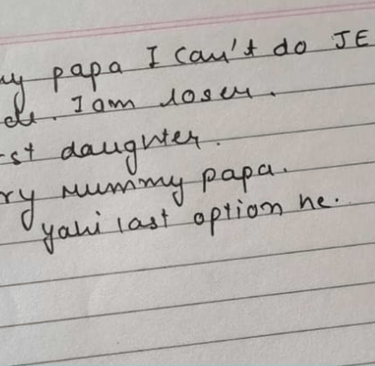Dr. (prof.) prabal frank nandwani (PFN)
Corporate Trainer † Clinical Psychologist † Astrologer † Healer † Author
Handwriting Reveals Suicidal Tendencies in a Recent Suicide Case of an 18-Year-Old Student in Kota
GRAPHOLOGY
Prof. (Dr.) Prabal Frank Nandwani
2/3/20242 min read


An 18-year-old student, Niharika, tragically died by suicide in the Borkheda area of Kota, Rajasthan, as reported on January 29, 2024. Niharika, who was preparing for the Joint Entrance Examination (JEE) scheduled for the following day, was found hanging in her residence. Reports suggest she was under intense pressure from the competitive exam environment. The detailed news story, as reported on the NDTV website, can be accessed here.
The police recovered a suicide note written in Niharika’s handwriting. Upon analysis, the handwriting revealed several traits indicative of suicidal tendencies.
Graphological Analysis of Suicidal Traits
The most fundamental sign of suicidal tendencies in handwriting is a word drop — a sudden descent of a word from the baseline. In Niharika’s handwriting, the word “suicide” displays a pronounced drop, a clear indicator of such tendencies.
Another crucial aspect to examine in handwriting with suicidal traits is the presence (or absence) of factors that could deter an individual from taking such a step. Historically, material possessions like money, relationships, degrees, or status have not been sufficient to prevent suicides. Instead, a person’s willpower and resilience, often linked to their spiritual quotient, play a decisive role. In graphology, we assess the ascenders of letters such as b, d, f, h, l, and t in the upper zone to gauge a person’s spiritual strength.
In Niharika’s handwriting, the ascenders are notably short and fail to extend into the upper zone. For instance, the ‘d’ in the word ‘daughter’ is nearly the same height as the adjacent letter ‘a.’ Similarly, letters like ‘h,’ ‘l,’ and ‘t’ lack the vertical stretch expected in the upper zone. This absence indicates a deficiency in willpower, leaving the individual vulnerable to overwhelming emotions and impulsive actions.
The Need for Early Intervention
Identifying such traits in students’ handwriting can serve as an invaluable preventive measure. Schools should consider incorporating graphological profiling to assess students’ mental well-being. Early detection of suicidal tendencies can pave the way for timely interventions, such as graphotherapy or psychotherapy, potentially saving lives.
This case underscores the importance of mental health awareness and proactive measures in educational settings. By integrating tools like graphology, we can better support students in navigating the pressures of academic life and safeguarding their mental health.
Connect with PFN
Get latest updates on PFN's work
Contact
+91 6262666111
© 2004-2025 Dr. Prabal Frank Nandwani. All rights reserved.
